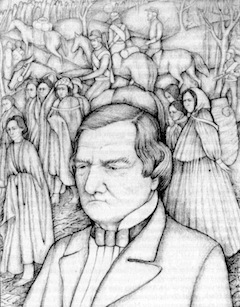|
J. William T. "Bill" Youngs, American Realities, Volume One:
Historical Episodes from First Settlements to the Civil War, Chapter Nine |
The Trail of Tears, by Robert Lindneux, courtesy of PBS
|
9. Limits of Jacksonian Democracy
|
SummaryAndrew Jackson’s election to the presidency in 1828 symbolized an age of new opportunity for the common man. The first chief executive born in a log cabin, Jackson proved that almost any man could rise to the highest post in America. During his administration, he championed democratic ideals by attacking the Bank of the United States as a privileged monopoly and promoting rotation in office to broaden political participation. While creating new opportunities for some Americans, however, he curtailed the rights of others. His Indian policy satisfied land-hungry whites but victimized the Native Americans. The Cherokees, who had lived for hundreds of years in the southern Appalachians, suffered especially at Jackson’s hands. In response to American policy, they had adopted many white customs early in the nineteenth century, only to be forced off their land in the 1830s to “protect” their native customs. Opportunity, it appeared, could damage one group while encouraging another.
|
Author Reads From the Text
The arrival of Gen. Winfield Scott’s troops in spring 1838 convinced the fourteen thousand Cherokees that the nightmare was a reality. Within a month most of the natives were imprisoned, suddenly reduced from citizens of a proud nation to a herd of refugees. Removing the Indians took almost a year; and although the federal government had promised to pay the cost, and General Scott attempted to provide well for the Cherokees, the migration decimated the tribe. In wagons and on foot the Indians made their way in large parties across Tennessee, Kentucky, Missouri, and Arkansas into new lands in Oklahoma. They called their route the Trail of Tears.
Many whites saw the Indians pass by on the road—their physical and spiritual suffering a ghastly sight. One traveler reported seeing Cherokees camped by the roadside, “under a severe fall of rain accompanied by heavy wind with their canvas for a shield from the inclemency of the weather, and the cold wet ground for a resting place.” As this traveler moved through Kentucky, he came upon other parties of Indians, many of them laboring over “the sometimes frozen ground . . . with no covering for their feet except what nature had given them.” At each camp Indians buried ten or a dozen comrades, the victims of cold, disease, and desolation. In all, four thousand Cherokees died on the Trail of Tears, including John Ross’s wife, who, according to legend, gave her only blanket to a dying child.
Many whites saw the Indians pass by on the road—their physical and spiritual suffering a ghastly sight. One traveler reported seeing Cherokees camped by the roadside, “under a severe fall of rain accompanied by heavy wind with their canvas for a shield from the inclemency of the weather, and the cold wet ground for a resting place.” As this traveler moved through Kentucky, he came upon other parties of Indians, many of them laboring over “the sometimes frozen ground . . . with no covering for their feet except what nature had given them.” At each camp Indians buried ten or a dozen comrades, the victims of cold, disease, and desolation. In all, four thousand Cherokees died on the Trail of Tears, including John Ross’s wife, who, according to legend, gave her only blanket to a dying child.
The Cherokee Trail of Tears
The "Trail of Tears" was actually four separate routes. Click on the "pins" below to see passages from American Realities that correspond to the locations. Click on any of the colored lines to get information on that particular route.
View American Realities - The Limits of Jacksonian Democracy: The Trail of Tears in a larger map

